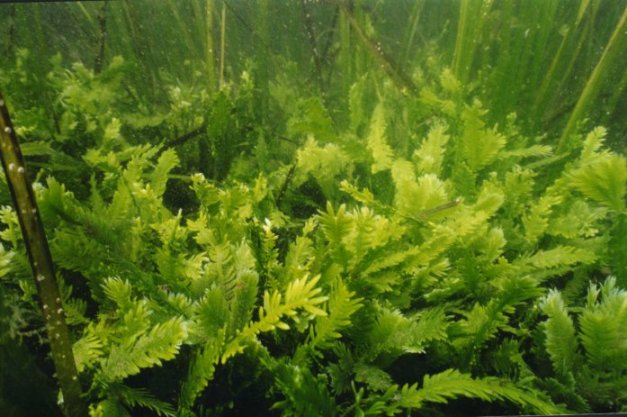Understanding images: A giant single-celled plant
This continues our series of blog posts from PLOS Genetics about our monthly issue images. Author Daniel Chitwood discusses January’s issue image from Ranjan et al
Author: Daniel H. Chitwood
Competing interests: Daniel H. Chitwood is an author of the article discussed in this blog.

Image Credit: Daniel H. Chitwood.
Multicellularity – especially in animals – is considered to be an important prerequisite for complex morphologies that it can enable. Land plants, too, are multicellular organisms that possess exquisite architectures comprised of leaf, stem, and root-like structures. Remarkably, from the mosses to the flowering plants, these organs arose independently multiple times during land plant evolution – an example of convergent morphology, suggesting functional significance conferred by similar structures.
But plants comprise many more lineages than just the land plants, and also include the green algae. Among the green algae are a plethora of shapes and forms [1]. There are single celled flagellated species like Chlamydomonas, and some green algae species can form spherical colonies, like in Volvox. Other multicellular lineages of green algae, like Trentepohlia, even became terrestrial, independently of the land plants, sometimes forming symbiotic lichens.
Some green algae are giant, single celled organisms with varied and complex morphologies; Acetabularia, with an anchoring rhizoid and mushroom-like cap, possesses a single, giant macronucleus. Grafting experiments between Acetabularia species with different shapes provided some of the first evidence that the nucleus contains genetic information [2]. Other siphonous algae, like Caulerpa, are true coenocytes, with multiple, numerous nuclei. Caulerpa species have been argued to be the largest free-living single celled organisms in the world, with stolons sometimes meters in length iteratively producing fronds that can be up to 60-80 cm long. One particular species, Caulerpa taxifolia, is especially interesting. It has been dubbed the “killer alga” and has been argued to have invaded coastal ecosystems around the world. Within its cytoplasm are endosymbiotic bacteria that may help in the uptake of nutrients from the holdfast, and it can completely regenerate itself if fragmented.
C. taxifolia possesses beautiful feather-like fronds emerging from a running stolon with holdfasts – features that convergently resemble land plants – showing that multicellularity is not required for the archetypal land plant form. Moreover, C. taxifolia challenges some of the corollaries of cell theory, e.g. the idea that organism-level properties are an emergent property of cellular phenomena.

Image credit: The Southwest Regional Office of the National Marine Fisheries Service.
If an organism consists of only a single cell, concepts like “tissue” and “organ” lack meaning; and yet C. taxifolia exhibits convergent land plant morphology. How?
In this issue of PLOS Genetics, we describe an intracellular transcriptomic atlas of gene expression within the giant-celled species C. taxifolia [3]. Predominant patterns of gene expression progress in a basal-apical direction, from the holdfast and stolon to the frond apex. Remarkably, the genes associated with these expression patterns track the progression of the gene expression process. Thus DNA polymerase II transcripts are highly expressed in the holdfast, and transcripts associated with nuclear activities, such as DNA replication, recombination, and repair, chromatin metabolism, and RNAi pathways are almost exclusively restricted to the stolon and basal frond region. Moving apically, translation-related transcripts are found in the frond rachis and pinnules, and at the frond apex, transcripts related to vesicular trafficking are enriched. Perhaps the most striking finding is that conserved groups of genes are co-expressed between organs of a land plant (tomato) and the pseudo-organs of C. taxifolia. For example, the stolon of C. taxifolia exhibits molecular homology with the meristematic tissue of tomato, consistent with this pseudo-organ producing lateral appendages, such as the frond and holdfast.
Donald Kaplan had eloquently argued for an “organismal theory” in plants rather than cell theory [4]. He asserted that cellular phenomenon had less to do with plant morphology than processes occurring at an organismal level. He even went so far as to argue that land plants are siphonous, exhibiting properties similar to giant coenocytes like Caulerpa, namely because of their symplasm and plasmodesmata. Caulerpa is the manifestation of organismal theory, and our work shows how the repercussions of organismal theory are borne out at a molecular level, where cellular compartments correspond to pseudo-organs, and gene expression patterns are conserved between morphological structures within a cell (Caulerpa) and between the cells comprising tissues (tomato and other land plants).
There is much more work to do. Are all the nuclei equally active in Caulerpa? Does the predominance of transcription-related transcripts and RNAi machinery in the stolon suggest these processes only occur there, implying long-distance molecular transport? If Caulerpa does exhibit nuclear dimorphism, does it follow a somatic/germline divide? And if not, do individual nuclei accumulate lineage-specific mutations, and what are the implications at a population genetic level? The novelty of a single celled organism convergently arriving at the same morphology as land plants is unique, and certainly the mechanisms that enabled such a feat will challenge fundamental assumptions about plant development.
1. Cocquyt E, Verbruggen H, Leliaert F, De Clerck O (2010) Evolution and cytological diversification of the green seaweeds (Ulvophyceae). Mol Biol Evol. 27: 2052-61.
2. Hämmerling J (1953) Nucleo-cytoplasmic relationship in the development of Acetabularia. J Intern Rev Cytol 2: 475-498.
4. Kaplan DR, Hagemann W (1991) The relationship of cell and organism in vascular plants. Bioscience 693-703.

[…] the zone. How a single-giant-celled plant partitions gene activity. Fascinating discovery, nicely explained by Daniel […]
[…] confronto con l'evoluzione della verdura acquatica, magari non vascolare? Chissà a quando risale la Caulerpa taxifolia, una procariota invadente che non ha né organi né tessuti, eppure imita la morfologia di […]